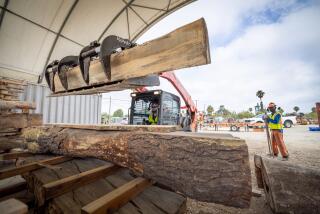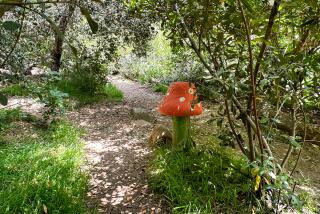Loggers Begin Harvest in Old-Growth Redwood Grove
Pacific Lumber Co. began salvage logging in an old-growth redwood grove in the privately owned Headwaters Forest on Monday, a week after signing an accord to protect some of the forest’s most sensitive trees.
Environmentalists condemned the return of loggers’ saws to the Headwaters, where timber cutting had been suspended to protect a threatened sea bird, the marbled murrelet, and while negotiations were underway to bring the forest under official protection.
Deputy U.S. Interior Secretary John Garamendi, who negotiated the agreement on behalf of the federal government, sharply criticized the logging operation, warning that it could undermine public confidence in the fragile pact, which is subject to a variety of conditions to be met over the next 10 months.
“It was the wrong thing to do and the wrong time to do it,” said Garamendi in a statement.
Garamendi said he had received an informal assurance from Pacific Lumber after the agreement was announced Sept. 28 that the company would not log any old-growth stands in the near future.
At the time, Pacific Lumber spokesmen denied Garamendi’s claim. On Monday, their logging crews began salvage operations in an area of old growth that is not covered by the accord. The company has state permission to take timber from this part of the forest, which is the last large stand of unprotected redwoods in California.
“What we are doing is allowed by both the letter and the spirit of the agreement,” said Bryan Oakley, a spokesman for Maxxam, Pacific Lumber’s Houston-based parent company.
The area being logged, identified as All Species Grove, was one of six stands of old-growth redwood and fir trees in the 60,000-acre Headwaters Forest that environmental groups had hoped to protect with the accord.
In the end, however, the agreement called for an asset swap in which Pacific Lumber would exchange two of the groves and adjacent buffer zones, totaling 7,500 acres, in return for $380 million of cash and real estate from the state and federal government.
The 7,500 acres are to become a public preserve.
The Headwaters has been the focus of controversy for 10 years as environmentalists and politicians sought to protect at least part of it. Charles Hurwitz, the chairman of Maxxam, said shortly after his firm took control of Pacific Lumber that he hoped to harvest the giant redwoods by early in the next century.
Besides containing many of the world’s oldest and tallest trees, the forest is home to several dwindling species, including the coho salmon, the northern spotted owl and the marbled murrelet.
During the next 10 months, the state and federal governments must come up with a package of assets acceptable to Pacific Lumber and the timber company must prepare a habitat conservation plan for the vast majority of the Headwaters not included in the exchange.
If those conditions are not met, the agreement can be canceled.
In the meantime, the company can conduct salvage logging on forest sections that are not part of the exchange, although that is being challenged in court by environmental groups who say such logging damages the forest.
Under salvage rules, Pacific Lumber must restrict its harvesting to dead and dying trees. For now, company officials have said they are not cutting down any standing trees, instead limiting their activities to removal of wood that has already fallen down.
According Ross Johnson, a spokesman for the California Department of Forestry, a three-man Pacific Lumber logging crew began work Monday in All Species Grove.
Johnson said the crew restricted itself to downed timber.
Environmentalists have asked the State Board of Forestry, which meets today near Mt. Shasta, to take action to block Pacific Lumber from further salvage operations in old-growth areas until it first submits an environmental impact report.
“Downed trees are essential to the forest ecosystem,” said Cecelia Lanman of the Environmental Protection Information Center in Garberville, one of the Northern California groups leading the campaign to preserve the Headwaters. “They conserve water, recycle nutrients into the forest floor and the roots of the trees and provide habitat for forest species.”
More to Read
Sign up for Essential California
The most important California stories and recommendations in your inbox every morning.
You may occasionally receive promotional content from the Los Angeles Times.










